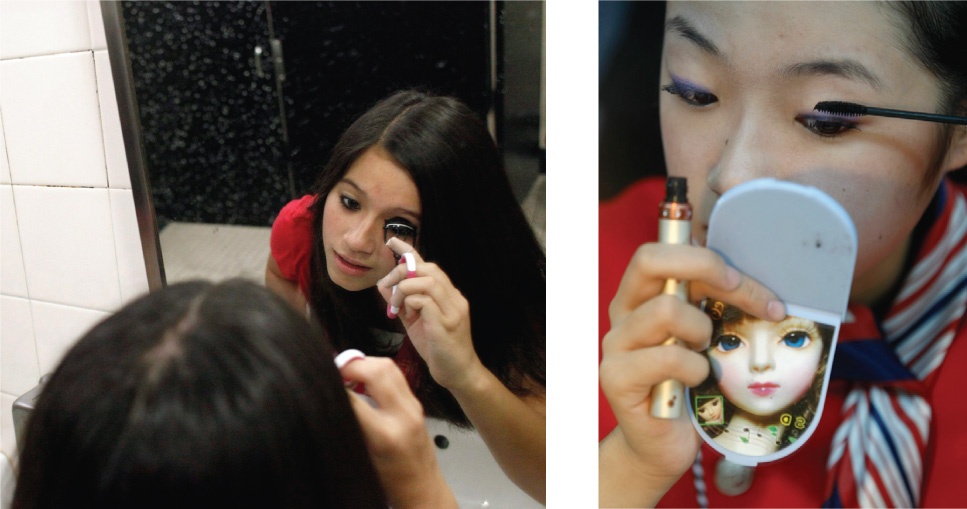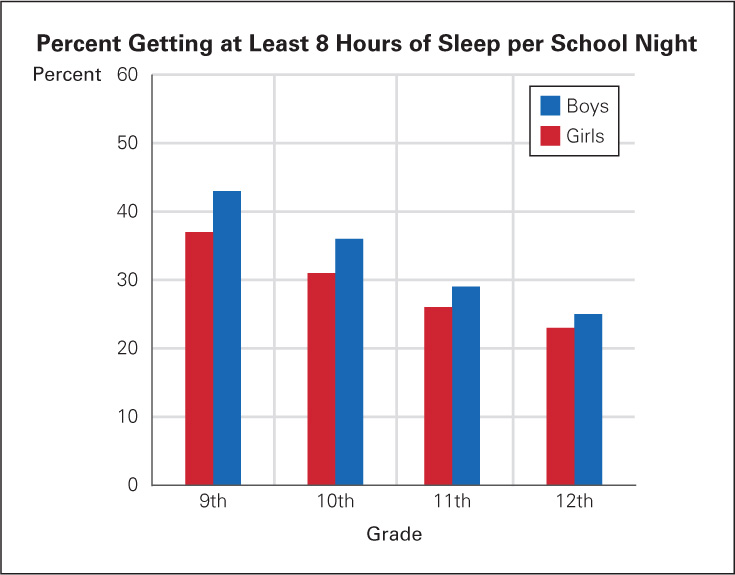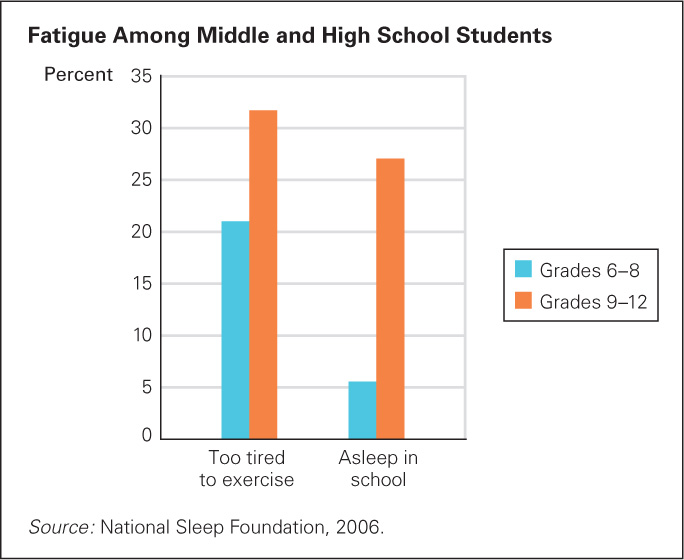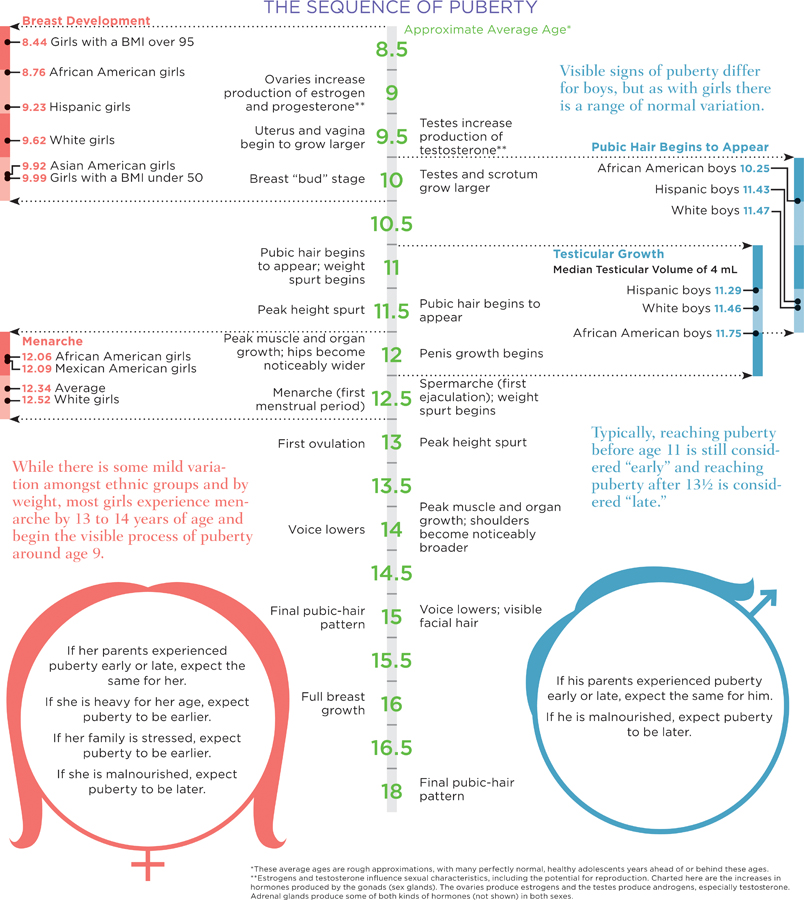 Puberty Begins
Puberty Begins
puberty The time between the first onrush of hormones and full adult physical development. Puberty usually lasts three to five years. Many more years are required to achieve psychosocial maturity.
Puberty refers to the years of rapid physical growth and sexual maturation that end childhood, producing a person of adult size, shape, and sexuality. The forces of puberty are unleashed by a cascade of hormones that produce external growth and internal changes, including heightened emotions and sexual desires.
The process of puberty normally starts between ages 8 and 14. Most physical growth and maturation ends about four years after the first signs appear, although some individuals (especially boys) add height, weight, and muscle until age 20 or so.
menarche A girl’s first menstrual period, signaling that she has begun ovulation. Pregnancy is biologically possible, but ovulation and menstruation are often irregular for years after menarche.
For girls, the observable changes of puberty usually begin with nipple growth. Soon a few pubic hairs are visible, followed by a peak growth spurt, widening of the hips, the first menstrual period (menarche), a full pubic-
spermarche A boy’s first ejaculation of sperm. Erections can occur as early as infancy, but ejaculation signals sperm production. Spermarche may occur during sleep (in a “wet dream”) or via direct stimulation.
For boys, the usual sequence is growth of the testes, initial pubic-
Unseen Beginnings
hormone An organic chemical substance that is produced by one body tissue and conveyed via the bloodstream to another to affect some physiological function.
These are the visible changes of puberty, but the entire process begins with an invisible event, a marked increase in hormones. Hormones are body chemicals that regulate hunger, sleep, moods, stress, sexual desire, immunity, reproduction, and many other bodily functions, including puberty. Throughout adolescence, hormone levels correlate with physiological changes and self-
pituitary A gland in the brain that responds to a signal from the hypothalamus by producing many hormones, including those that regulate growth and that control other glands, among them the adrenal and sex glands.
adrenal glands Two glands, located above the kidneys, that produce hormones (including the “stress hormones” epinephrine [adrenaline] and norepinephrine).
You learned in Chapter 8 that the production of many hormones is regulated deep within the brain, where biochemical signals from the hypothalamus signal another brain structure, the pituitary, to go into action. The pituitary produces hormones that stimulate the adrenal glands, located above the kidneys at either side of the lower back. The adrenal glands produce more hormones.
HPA (hypothalamus–
Many hormones that regulate puberty follow this route, known as the HPA (hypothalamus–

FIGURE 14.1
Biological Sequence of Puberty Puberty begins with a hormonal signal from the hypothalamus to the pituitary gland, both deep within the brain. The pituitary, in turn, sends a hormonal message through the blood stream to the adrenal glands and the gonads to produce more hormones.Indeed, abnormalities of the HPA axis probably cause the sudden increases in clinical depression in early adolescence (Guerry & Hastings, 2011), HPA disruptions are one result of childhood sexual abuse (discussed soon) (Trickett et al., 2011).
Especially for Parents of Teenagers Why would parents blame adolescent moods on hormones?
Response for Parents of Teenagers: If something causes adolescents to shout “I hate you” to slam doors, or to cry inconsolably, parents may decide that hormones are the problem. This makes it easy to disclaim personal responsibility for the teenager’s anger. However, research on stress and hormones suggests that this comforting attribution is too simplistic.

JASON LEE/REUTERS/LANDOV
Sex Hormones
gonads The paired sex glands (ovaries in females, testicles in males). The gonads produce hormones and gametes.
HPG (hypothalamus-
estradiol A sex hormone, considered the chief estrogen. Females produce much more estradiol than males do.
testosterone A sex hormone, the best known of the androgens (male hormones); secreted in far greater amounts by males than by females.
At adolescence, the pituitary activates not only the adrenal glands but also the gonads, or sex glands (ovaries in females; testes, or testicles, in males), following another sequence called the HPG (hypothalamus–
Estrogens (including estradiol) are female hormones and androgens (including testosterone) are male hormones, although both sexes have some of both. The biochemical messages from the HPG axis activate the ovaries to produce high levels of estrogens and the testes to produce dramatic increases in androgens. This “surge of hormones” affects bodies, brains, and behavior before any visible signs of puberty appear, “well before the teens” (Peper & Dahl, 2013, p. 134).
The activated gonads eventually produce mature sperm or ova, released in men-
Especially for Teenagers Some 14-
Response for Teenagers: No. Early sex has many hazards, but it is true that pregnancy is less likely (although quite possible) before age 15. However, this may lead to a false sense of security: Conception is more likely in the late teens than at any other period in the life span.
However, the most obvious psychological effect of hormones at puberty is to awaken and increase interest in sex. The first sexual objects are usually unattainable—
Not only are bodies and brains affected by hormones, behavior is as well—
Emotional surges and lustful impulses may begin with hormones, but then thoughts themselves can cause physiological and neurological processes, not just result from them. The hormones of puberty make young adolescents more vulnerable to stress, and thus quicker to become angry or upset (Goddings et al., 2012; Klein & Romeo, 2013). Then those emotions increase hormone levels. For example, other people’s reactions to emerging breasts, beards, or body shapes evoke adolescent thoughts and frustrations that result in increased hormone production and emotional outbursts, each increasing the other.
Body Rhythms
circadian rhythm A day-
The brain of every living creature responds to the environment with natural rhythms that rise and fall by the hours, days, and seasons. For example, body weight and height are affected by time of year: The rate of child growth increases for height in summer and for weight in winter. Some biorhythms are on a day-

The hypothalamus and the pituitary regulate the hormones that affect patterns of stress, appetite, sleep, and so on. These hormones at puberty cause a phase delay in the circadian sleep–
Added to the adolescent day–
To make it worse, “the blue spectrum light from TV, computer, and personal-
Sleep deprivation and irregular sleep schedules lead to several specific dangers, including insomnia, nightmares, mood disorders (depression, conduct disorder, anxiety), and falling asleep while driving. In addition, individuals who are sleepy do not think or learn as well as they might when rested.
Sleep deprivation is particularly likely among adolescents, not only in the United States but also in many other nations (Eaten et al., 2010; Roenneberg et al., 2012). Every year of high school, fewer students get even 8 hours of sleep, the minimum needed by a young body (see Figure 14.2). Many adults ignore the implications, as the following Opposing Perspectives explains.
Observation Quiz As you see, the problems are worse for the girls. Why is that?
Answer to Observation Quiz: Girls tend to spend more time studying, talking to friends, and getting ready in the morning. Other data show that many girls get less than 7 hours of sleep per night.

FIGURE 14.2
Sleepyheads Three of every four high school seniors are sleep deprived. Even if they go to sleep at midnight, as many do, they must get up before 8, as almost all do. Then all day they are tired.OPPOSING PERSPECTIVES
Algebra at 7 A.M.? Get Real
Parents sometimes fight biology. They might command their wide-

FIGURE 14.3
Dreaming and Learning? This graph shows the percentage of U.S. students who, once a week or more, fall asleep in class or are too tired to exercise. Not shown are those who are too tired overall (59 percent of high school students) or who doze in class “almost every day” (8 percent).Meanwhile, adolescents fight parents. Among the reasons is their circadian rhythm that makes early bedtime and early rising almost impossible. Sleep-
Data on the circadian rhythm and the teenage brain convinced social scientists at the University of Minnesota to ask 17 school districts to start high school at 8:30 a.m. or later. Parents disagreed. Many (42 percent) thought high school should begin before 8:00 a.m. Some (20 percent) wanted their teenagers out of the house by 7:15 a.m., as did only 1 percent of parents with younger children (Wahlstrom, 2002).
Other adults had their own reasons for wanting high school to begin early. Teachers generally thought that learning was more efficient in the morning; bus drivers hated rush hour; cafeteria workers liked to be done by mid-
Only one school district tried a later start time. In Edina, Minnesota, high school schedules changed from 7:25 a.m.–2:05 p.m. to 8:30 a.m.–3:10 p.m. After a trial year, most parents (93 percent) and virtually all students liked the new schedule. One student said, “I have only fallen asleep in school once this whole year, and last year I fell asleep about three times a week” (quoted in Wahlstrom, 2002, p. 190). Fewer students were absent, late, disruptive, or sick (the school nurse became an advocate). Grades rose.
Other school districts noticed. Minneapolis high schools changed their start time from 7:15 a.m. to 8:40 a.m. Again, attendance and graduation rates improved. School boards in South Burlington (Vermont), West Des Moines (Iowa), Tulsa (Oklahoma), Arlington (Virginia), Palo Alto (California), and Milwaukee (Wisconsin) voted to start high school later, from an average of 7:45 a.m. to 8:30 a.m. (Tonn, 2006; Snider, 2012), as did one private school in Rhode Island (Owens et al., 2010). Unexpected advantages appeared: more efficient energy use, less adolescent depression, and, in Tulsa, unprecedented athletic championships.
Many school districts stick to their traditional schedules, set to allow school buses to take teenagers to school and then come back for the younger children. That was before the hazards of sleep deprivation were known. Now the evidence is clear, “the science is there, the will to change is not” (Snider, 2012).
From 1990 to 2009, the community of Fairfax (Virginia) argued, forming two opposing groups: SLEEP (Start Later for Excellence in Education Proposal) versus WAKE (Worried About Keeping Extra-
The later start would hinder teams without lighted practice fields. Hinder kids who work after-
[Williams, 2009]
This writer wrote that science was on the side of change but reality was not. To developmentalists, of course, science is reality. However, in 2009 the Fairfax school board voted to keep high school start at 7:20 a.m. The advocates kept trying. On the eighth try, the Fairfax school board in 2012 finally set a goal: High schools should not start before 8 a.m. They hired a team to figure out how to implement that goal.
Age and Puberty
Normally, hormones increase between age 8 and 14, and visible signs of puberty appear a year later. That six-
Genes and Gender
About two-
The sex chromosomes have a marked effect. In height, the average girl is about two years ahead of the average boy. However, the female height spurt occurs before menarche, whereas for boys, the increase in height is relatively late, after spermarche. Thus, when it comes to hormonal and sexual changes, girls are less than a year ahead of boys (Hughes & Gore, 2007). A sixth-
Observation Quiz What three body differences that show adolescent growth do you see?
Answer to Observation Quiz: Actually, puberty affects every part of the body, so far more than three changes are visible, including longer arms, legs, and torso; more arm and leg muscle; visible nipples; less round head; and a more mature facial expression. The younger boy will change soon—

Body Fat
Another major influence on the onset of puberty is body fat, at least in girls. Heavy girls reach menarche years earlier than malnourished ones do. Most girls must weigh at least 100 pounds (45 kilograms) before they experience their first period (Berkey et al., 2000). Although malnutrition always delays puberty, body fat may not be as necessary for well-
Worldwide, urban children are more often overfed and underexercised compared with rural children. That is probably why puberty starts earlier in the cities of India and China than it does in their more remote villages, a year earlier in Warsaw than in rural Poland, and earlier in Athens than in other parts of Greece (Malina et al., 2004).
Body fat also explains why youths reach puberty at age 15 or later in some parts of Africa, although their genetic relatives in North America mature much earlier. Similarly, malnutrition may explain why puberty began at about age 17 in sixteenth-
secular trend The long-
Since then, puberty has occurred at younger and younger ages (an example of what is called the secular trend, the trend for changes in human growth as nutrition improved). Increased food availability has led to weight gain in childhood, and that has led to earlier puberty and taller average height. Because of the secular trend, for centuries every generation has reached puberty before the previous one (Floud et al., 2011; Fogel et al., 2011).
One curious bit of evidence of the secular trend is that U.S. presidents are taller in recent decades than they were earlier (James Madison, the fourth president, was shortest at 5 feet, 4 inches; Barack Obama is 6 feet, 1 inch tall). The secular trend has stopped in developed nations, because now nutrition allows everyone to attain their genetic potential. Currently, young men no longer usually look down at their short fathers, or girls at their little mothers, unless they were born in Asia or Africa, where the secular trend continues.
VISUALIZING DEVELOPMENT
The Timing of Puberty
The process of puberty can take years—

SOURCE: ANDERSON/MUST, 2005.
SOURCE: BIRO ET AL., 2013.
SOURCE FOR BOY DATA: HERMAN-
There is one possible exception in developed nations to the statement “the secular trend has stopped.” Puberty that begins before age 8, called precocious puberty, seems more common, although still rare (perhaps 2 percent). The increase may be caused by more childhood obesity or by new chemicals. Experts disagree about both prevalence and causes.
Hormones
Of course, hormones as well as genes affect sex differences, height, and weight, but additional factors may directly trigger the onset of puberty. Many scientists suspect that precocious or delayed puberty is caused by substances in the food supply. Cattle are fed steroids to increase bulk and milk, and hundreds of chemicals and hormones are used to produce most of the food and drink that children consume. All these might affect appetite, body fat, and sex hormones, with effects particularly apparent at puberty (Wang et al., 2005).
leptin A hormone that affects appetite and is believed to affect the onset of puberty. Leptin levels increase during childhood and peak at around age 12.
One hormone naturally produced by the body definitely affects the onset of puberty. That hormone is leptin, which regulates appetite and energy. Without leptin, puberty does not occur. However, abnormally high levels of leptin correlate with obesity. A girl with this problem is likely to experience early puberty that ends relatively soon, stopping growth. Thus the fattest girl may become the tallest 5th grader and then the shortest high school graduate.
Especially for Parents Worried About Early Puberty Suppose your cousin’s 9-
Response for Parents Worried About Early Puberty: Probably not. If she is overweight, her diet should change, but the hormone hypothesis is speculative. Genes are the main factor; she shares only one-
Normally, body fat produces leptin (one reason puberty is delayed is if a person overexercises or undereats), and starvation usually increases leptin so the hungry person seeks food. Once weight is gained, higher levels of leptin decrease the appetite (Elias & Purohit, 2013). Most of the research on leptin has been done with mice, which become fat or thin depending on the levels of this hormone, but the picture is more complicated for humans.
The precise impact of all the chemicals in the air, water, or diet on the human sexual-
Stress
Stress hastens the hormonal onset of puberty, especially if a child’s parents are sick, drug addicted, or divorced, or if the neighborhood is violent and impoverished. One study of sexually abused girls found that they began puberty seven months earlier, on average, than did a matched comparison group (Trickett et al., 2011). Particularly for girls who are genetically sensitive, puberty comes early if their family interaction is stressful but late if their family is supportive (Ellis et al., 2011; James et al., 2012).
Thus the age of menarche is influenced by the child’s genes as well as by the family situation, as differential sensitivity would predict. [Lifespan Link: Differential sensitivity was explained in Chapter 1.] Minor stresses—
A VIEW FROM SCIENCE
Stress and Puberty
Hypothetically, stress effects on puberty could be indirect, a marker for other factors, not a direct cause of early puberty. For example, it is possible that children in dysfunctional families eat more unhealthy food (thus gaining excessive weight), or they inherit genes from their distressed mothers for early puberty, and those genes led the mothers to become divorced. Either of those possibilities could be the cause of early puberty.
However, several longitudinal studies show a direct link between stress and early puberty. For example, one study of 756 children found that early menarche correlated with harsh parenting a decade earlier. Their parents tended to demand respect, spank often, and rarely hug them as babies (Belsky et al., 2007). It is known that such early parenting might increase the level of the stress hormone, cortisol, and it is also known that cortisol affects puberty, so the link between stress and puberty is plausible.
A further study of the same girls at age 15, controlled for genetic differences, found that harsh treatment in childhood increased sexual risk (more sex partners, pregnancies, sex-
Why would higher cortisol trigger puberty? Given what is known about optimal development, it makes more sense for stress to delay puberty. If puberty were delayed, then young teens would still look and act childlike, which might evoke adult protection for the child rather than lust or anger at the teenager. Protection is especially needed in conflict-
One explanation comes from evolutionary theory:
Maturing quickly and breeding promiscuously would enhance reproductive fitness more than would delaying development, mating cautiously, and investing heavily in parenting. The latter strategy, in contrast, would make biological sense, for virtually the same reproductive-
[Belsky et al., 2010, p. 121]
In other words, historically, when harsh conditions threatened survival of the species, it was crucial that adolescents reproduce early and often. Natural selection would hasten puberty to increase the birth rate, especially if many adults died before their reproductive years were over.
By contrast, in peaceful times, puberty could occur later, allowing children to postpone maturity and instead enjoy extra years of nurturance from parents and grandparents. Genes evolved to respond differentially to war and peace.
Of course, this evolutionary rationale no longer applies. Today, early sexual activity and reproduction are more likely to destroy societies than protect the species. However, the genome has been shaped over millennia; if there is a puberty-
Too Early, Too Late
For most adolescents, the link between puberty and hormones is irrelevant. Only one aspect of pubertal timing is important: their friends’ schedules. Puberty can enhance or diminish a person’s status with peers. No one wants to be too early or too late.
Girls
Think about the early-
Observation Quiz Who is least developed
Answer to Observation Quiz: Impossible to be sure, but it seems as if the only one smiling is the least developed (note the size of her hands, the narrowness of her hips, and her height); the one on the left is the most developed (note hips, facial expression, height, and—

Sometimes early-
Early-
Boys
Research over the past 100 years has always found that early female maturation is more harmful than helpful, but cohort seems crucial for males. Early-
In the twenty-
For both sexes, early puberty correlates with sexual activity and teenage parenthood, which in turn correlate with depression and other psychosocial problems (B. Brown, 2004; Siebenbruner et al., 2007). Not only is early puberty stressful, but speed of change is difficult as well: The boys most likely to become depressed are those for whom puberty was both early and quick (Mendle et al., 2010). In adolescence, depression is often masked as anger. That fuming, flailing 12-
Late puberty may also be difficult, especially for boys (Benoit et al., 2013). Slow-
Every adolescent wants to hit puberty “on time.” They often overestimate or underestimate their maturation, or become depressed, if they are not average (Conley & Rudolph, 2009; Shirtcliff et al., 2009; Benoit et al., 2013). However, the effects are not caused by biology alone; family contexts and especially peer pressure can make early and late puberty worse (Mendle et al., 2012; Benoit et al., 2013).
Ethnic Differences
Puberty that is late by world norms, at age 14 or so, is not troubling if one’s friends are late as well. Well-
Variable timing may add to intergroup tensions in multiethnic schools. For instance, in one New England high school, the shorter and thinner “quiet Asian boys” were teased, much to their dismay. When one larger Asian American boy fought back at an ethnic insult, he was a hero to his Asian peers, even though school authorities punished him for his actions (Lei, 2003). In a California high school, Samoan students were a small minority of the school population but advanced in puberty. That earned them respect from their classmates. They were accepted as peacemakers between the two more numerous groups, African and Mexican Americans (Staiger, 2006).
Size and maturation are important for adolescents in every nation. For example, a study of more than 3,000 Australian students, primarily of English heritage, found that late developers had four times the rate of self-
Further studies have confirmed the correlation between off-
SUMMING UP
Puberty usually begins between ages 8 and 14 (typically around age 11) in response to a chain reaction of hormones from the hypothalamus to the pituitary to the adrenal and sex glands. Hormones affect emotions as well as the body: Adolescent outbursts of sudden anger, sadness, and lust are caused not only by hormones, but also by reactions from other people to the young person’s changing body. Those reactions cause emotional responses in the young person, and then emotions affect hormones, which triggers additional behavior.
The dynamic interaction among hormones, genes, adolescent behavior, and social regulations is evident in the circadian rhythm and high school schedules. Many teenagers are sleep deprived, which affects their learning and emotions.
Genes, body fat, hormones, and stress affect the onset of puberty, especially among girls. For both sexes, early or late puberty is less desirable than puberty at the same age as one’s peers; off-